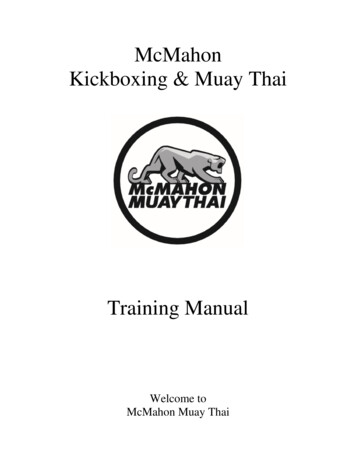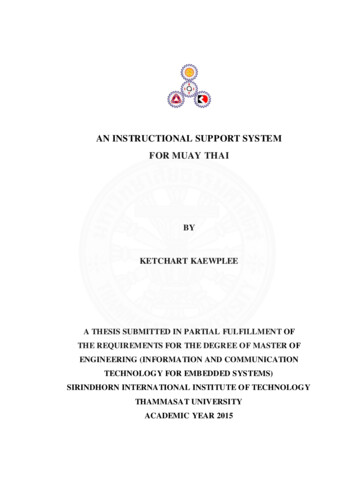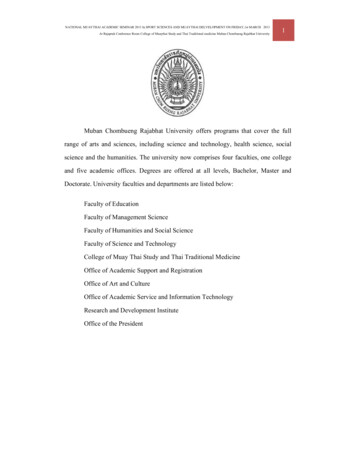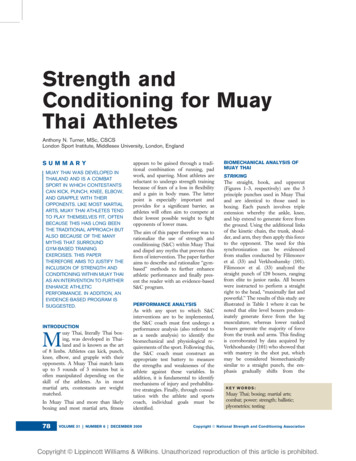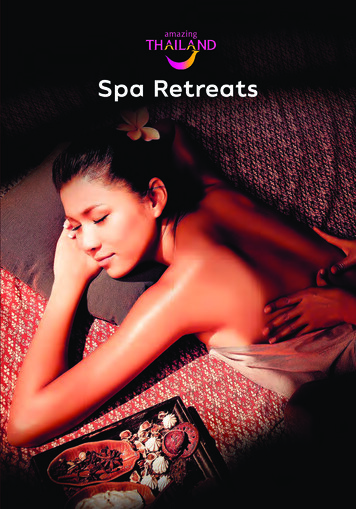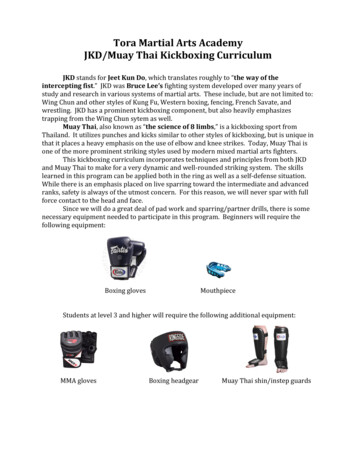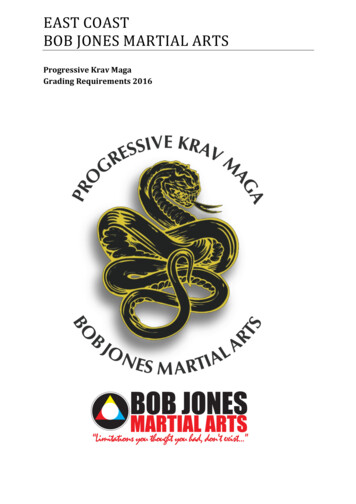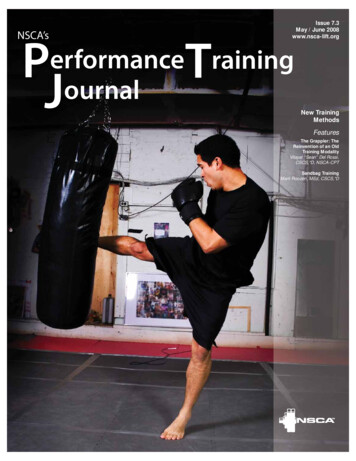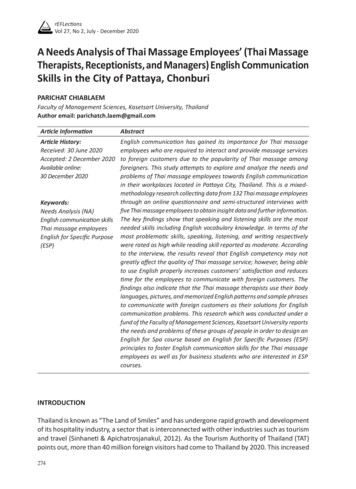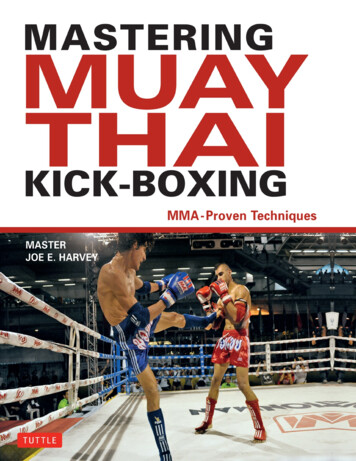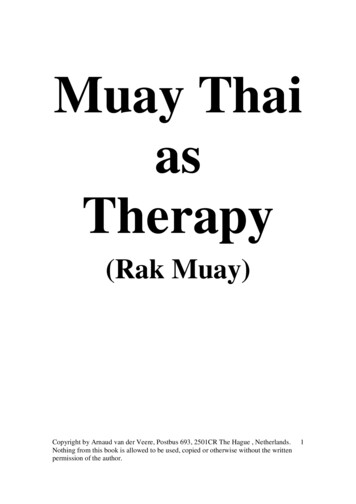
Transcription
Muay ThaiasTherapy(Rak Muay)Copyright by Arnaud van der Veere, Postbus 693, 2501CR The Hague , Netherlands.Nothing from this book is allowed to be used, copied or otherwise without the writtenpermission of the author.1
WORDS OF GRATITUDELife is a never ending lesson. During my years of training so many people did pass bythat the list to thank will be sheer endless. To all who thought me something I would liketo give my respect and honor them with this book. The first person in my life who didopen the Thai world of literature, art and craft is Sudasawan Wiraprasert who is also thehonorable mother of my children. She did teach me a lot on the Thai way of thinking andwe had endless discussions on the differences and similarities in culture. After this mychildren are the greatest supporters a father can have Arayana,, Anoma and Erawan !I also would like to thank Ruamporn Pantunatviriyakul, who always tried to find a way tosupport my work in Thailand by frequently contacting publishers, writing mails, callingand all what is possible to make things happening.This is my first book in Thailand but many have already been published all over theworld. For this I would like to thank Mr. Zhang Wei from Peoples Medical PublishingHouse in Beijing, China, Mr Du Du from China Publishing Group in Beijing , China .Miss Nova Rasdiana, Gramata Publishing , Bekasi 17421, Indonesia. Meyer & MeyerSport, Germany. Max Roodnat, Elmar Sportpublishing, Delft, Netherland. Diana Kamies,Sport & Fitness magazine, Netherlands.Copyright by Arnaud van der Veere, Postbus 693, 2501CR The Hague , Netherlands.Nothing from this book is allowed to be used, copied or otherwise without the writtenpermission of the author.2
CONTENTAbout this bookIntroductionGroups training programsIndividual with a guideDIY Do it Yourself programCopyright by Arnaud van der Veere, Postbus 693, 2501CR The Hague , Netherlands.Nothing from this book is allowed to be used, copied or otherwise without the writtenpermission of the author.3
ABOUT THIS BOOKFighting arts are all over the world. The amount of participants increase every day. Butresistance from the “regular” communities are often opposed to it as they are more or lessscared that the sport – in their eyes it is violence – gets into the hands of wrongdoers.Gladly it is proven time after time that long term participants of fighting arts are lessaggressive, and in general, have a better mood, better mental stability, physical condition,reflexes and most of the time a better social awareness and will to serve instead of ruling.Ringsport is not a macho exploitation of the human body with a need to prove one isbetter than the other. Competition is a fight within oneself, the eager to pass borders andlevels is the heart of a real fighter. Aggression is dangerous for any fighter. Losingcontrol over body and mind is the fear of every competitor.In this book everybody can find every part of information necessary to practice the sportsin a proper way and for the advance students it is the road to become a teacher, trainer orcoach. The collected information is from a period of over forty years of day to daypractice and learning.Fighting art is a never ending story of development, innovation and practice, this book isyour guide. New elements can be found on the website ; www.arnaudvanderveere.nlKeep in mind at all pages of this book ; fighting is against violence, we practice a sportand have respect for the opponent , we will never use it unreasonably nor aggressively. Ifused for defense remember that you do this as far as the need is to make the attacker runor stop attacking and not further than that.Customer versus patient. One very important issue in this book is that we are not dealingwith patients, I prefer the word customer. Each person I met in my life had some kind ofspecial thing which could be labeled as a problem. I am not excluded from that. The bigquestion is ; what is the standard of a perfect human being ? The answer is simple ; thereis no such thing as a standard or perfect person.Let me compare a real fact and a personality. We take the mathematical fact of thestraight line. It is possible to proof that a straight line will be straight under everycircumstance and will never be bend or changed, it is a fixed fact. To any human beingthere is no such thing as a straight line, not in movement, in thinking or behaving. A realhuman being is not capable to copy the absolute straight line. Each individual will drawthe straight line in a different way. We differ not only in our DNA but also in thinkingand behavior, there is not a single person who has a full copy, not even the “perfect”twin.In my vision a patient is a person who has (severe) mental are physical problems thatmedical help is evidently needed. I am not a medical doctor nor are most of my studentsor readers. This is one of my main reasons why I will not call the persons I treat , assist orCopyright by Arnaud van der Veere, Postbus 693, 2501CR The Hague , Netherlands.Nothing from this book is allowed to be used, copied or otherwise without the writtenpermission of the author.4
help a patient, they are like me a customer who needs a service at that moment, not moreor less.The target of this book is multifunctional. It is not my intention to explain the use or eventhe technical side of Muay Thai, if the reader wants to know more about that he/she iswelcome to read my other books. This book is how to use the spiritual side of the sportfor personal benefit and help. I will focus on three different ways to approach the therapy; Group Individual under guidance Single individual approachGroup therapy is designed for classes of around ten plus people. Each individualparticipating in the group therapy has to be aware of the targets set by the group andsupport these goals for their own benefit. Depending on the age we use a play or a moreserious element. From experience group therapy in larger groups is maximum effectivewith very clear outlined goals. Each goal must be possible and relatively easy to reach forall participants.Individual under guidance is focused on a one-on-one meeting. We use these kind ofmeetings in general to get the maximum result in the shortest possible time. Within aninterpersonal context it is often easier for both to come to the core of the problem. It isimportant that both parties go into the meeting with the same thing in mind ; we have tofind a solution for a specific problem. This kind of therapy takes one person with theproblem and one person with the knowledge to solve the problem, this must be a veryclear agreement of trust between the two. Here I would like to state that between thesetwo persons there must be no close personal relationship, nor physical or mentally.Family and friends are often bad advisors in critical situations. In most Asian societies itis not common to ask a third person to interfere in a personal problem but it is proven amillion times that an independed third party solves a problem faster than a closerelationship. In Thailand we often consult a monk in the past, currently this trend seemsto move to medical doctors who are not my favorite advisors in these cases. Most medicalspecialist of today are well trained commercial entrepreneurs and do have more interestin the selling of medications than in the solution of a problem.The single / individual approach is considered a DIY Do It Yourself way of healing. Itis my strong believe that this is the core of all solutions. To find a your very own personalsolution to a problem is the best but never the easiest way. The most important part offinding a personal solution is the possibility to distant yourself from the problem. In thisbook I use some Buddhism oriented philosophy to support the idea of self-growth. I dohave to emphasis that the used theory is not completely based on the original teachingsbut have been adapted to the current time frame. I am not an expert in Buddhist history ortraditions as I have focused myself on only the parts that were practical of application inthe daily life.Copyright by Arnaud van der Veere, Postbus 693, 2501CR The Hague , Netherlands.Nothing from this book is allowed to be used, copied or otherwise without the writtenpermission of the author.5
In my more than 40 years of experience I found that DIY training sessions are the mostrewarding but also stabilizing ways of creating a strong personality with a balanced mind.Daring to observe, change and be critical on yourself is not easy, it takes an open mind toanalyze the personal behavior, attitude and mindset in a SWOT way. SWOT analyzingyour Strength, Weakness but also your Opportunities and the Threats we encounter. Thisbook will guide you through the process of making it happen.Copyright by Arnaud van der Veere, Postbus 693, 2501CR The Hague , Netherlands.Nothing from this book is allowed to be used, copied or otherwise without the writtenpermission of the author.6
INTRODUCTIONMuay Thai is original a Thai sport. Created and grown in Thailand but exported in the‘70’s at first to Europe to get over the world later on. The first country taking over thecompetition level of the sport was Holland.Muay Thai cannot be seen as just only a physical way of movement. The history andculture of Muay Thai is connected with the theory and practical side of Buddhism. Manyof its theoretic backgrounds will reflect in the way how my interpretation and use of thesport as therapy is. It is important to know that to understand the practical implication ofBuddhism during the therapy it is purified from side believes and contaminations ofsocial, cultural, religious or ritual matters. I have nothing against these things but in myvision many are even the cause of problems with many people. One of the most luringdangers in life is superstitions. Many people are victim to these unfounded believeswhich can haunt a person heavily during life.This program is designed to promote the training of Muay Thai as Therapy (or RakMuay)as a therapy. Right at the start it is important to point out the similarities anddifferences of the Muay Thai as Therapy (or Rak Muay)approach in the Thai and Dutchversion.Individual approachGroup approachRecreational levelStimulation of individualCompetitionTraining methodsCommercialDutchThis only happens when aperson is able to afford it,we can consider it the richpersons optionThe standard approach isduring a groups lessonAll lessons are designed tobeenjoyableand“entertaining”The group will pull theindividual to a higher and“competitive” level99% of the participantsnever enter a competitionlevel, but enjoy the lessonsin fullVariations and permanentaddition of new techniquesto keep the enjoy level ashigh as possibleOutside Thailand this is theonlyrightapproach,individual approach is toexpensiveThaiStraight from the beginninga person is approached as afighterNo group approachNo entertainment levelPersonal and result directedapproach99% practice the sport asprofessional, no amateurismTraditional approach basedon repetition of samemovements for thousands oftimesFor Thai this is currentlythe only approach, grouplessons only work in certainarea’sCopyright by Arnaud van der Veere, Postbus 693, 2501CR The Hague , Netherlands.Nothing from this book is allowed to be used, copied or otherwise without the writtenpermission of the author.7
The above mentioned facts are your guidelines to point out targets. A trainer outsideThailand mainly will deal with groups.What is therapy ? A short question with a relative short answer. Therapy, as how I see it,is a way to help a person to solve specific problems.Nearly everything can be used as therapy when it serves the right purpose to reach thegoal ; solve a problem.Our target is to show you as many ways to use Muay Thai as Therapy (or Rak Muay)tohelp solving problems but also help to solve the problems of others. With this book Ihope to stimulate the use of the sport in a non-competitive positive and constructive wayin our society. IN Thailand we are dealing with many environmental problems that aresplitting our daily live. We have to deal with a splitting political thinking, often witheconomical blows and a fast changing society. Muay Thai as Therapy (or Rak Muay)as atherapy teaches more than movements. We will target the trust and loyalty between twoor more persons. Trust is something we slowly see diminish in the society, many peopledo not feel any confident in tomorrow. Many see tomorrow as a dark spot where moreproblems occur.Copyright by Arnaud van der Veere, Postbus 693, 2501CR The Hague , Netherlands.Nothing from this book is allowed to be used, copied or otherwise without the writtenpermission of the author.8
PHILOSOPHY OF THE FIGHTERFirst of all, I have to set something straight. The word “fighter” is considered negative inthe common language usage, but fighting is positive attitude. Remember when someonetold you that it was worth to fight for your life, your work, your relationship, your job?We all need to be a fighter in life; nothing comes for granted. Fighting is a very importantword that equals determination. In this book, we want to make clear what we consider tobe a fighter and show how we consider it to be a positive attitude toward a serious role insociety. We all want to make a better, positive society.What do we consider a fighter? Is it only a person who is involved in competitions or alsothe one who is involved in training in the gym? In my opinion, anyone who is seriouslyworking out in training at least three to four times is a week a “fighter,” whether male orfemale. As a fighter, it is important to have a training philosophy, something I call the“way of the warrior.” . Maybe you remember the concept stated by the film actor BruceLee, who always was talking of the way of the warrior.The main goal of a fighter is not to fight the opponent or partner. The goal is to excel, tobecome better at every training session, become more skillful, develop more power and abetter physical condition. Each training session is a chance to be a better person thanbefore.A real fighter works on his or her inner peace and balance. The fighter must be focusedon the perfection of techniques, breathing, focus , timing, food, lifestyle. All of this iswill make him or her better in what he or she is doing. The fighting is best shown on daysyou feel the body is hurting badly and you only wish to rest. During that time your bodywants to control your mind and not the other way around. It takes hard work anddetermination to start moving thru the pain of last sessions. The change from body overmind to mind over body is not easy and will take a lot of effort. Not everybody is able todo this. A real fighter only emerge when showing the determination and character oftrying and daring. Many parents want to know how I can relate this kind of determinationto the work in school or even on the working place. In fact it is easy to explain. Manypeople in our society gets beaten up daily by college or fellow students. These othersshow more results, better marks , have better connections or sometimes are more smoothtalkers. We get a beating from the fact they get the better jobs, the easier targets and oftenthe better salary or results. This seems unfair and we get hurt. But we have to move thruthe hurt and show our real fighting spirit by determination to do better, have higherresults and on the long term pass these others, let them behind. In the next parts I willrelate some special features that are very useful for the fighter to create a personalphilosophy. Every fighter should have a personal target in life, no matter what it is, itmust be the fuel of your soul, the source of your inspiration and the fire that keeps yougoing.Meditation is one also of the most important parts of a good fighter. Most people thinkthat meditation is only done by sitting and breathing – controlling the mind, the thoughts.But a fighter meditates in activity. During a workout, the focus of the mind, theCopyright by Arnaud van der Veere, Postbus 693, 2501CR The Hague , Netherlands.Nothing from this book is allowed to be used, copied or otherwise without the writtenpermission of the author.9
perfection of breathing, the reflexes and drills, are part of the meditation of the fighter.When working out, the mind turns to an inward-oriented position and, while the body ismoving under the commands of trainer or task, the fighter’s mind is no longer busy withthe thoughts and problems of the everyday life. These problems vanish and become onewith the overall exercise of mind and body.As we mentioned before there is a mind over body situation needed in the fighting artslike there is in meditation classes. Most meditation classes are combined with physicalmovements like Yoga. In real fighting arts we will train the body in sheer active statesometimes until exhaustion to keep it going. Exhaustion does not refer to pain but to aconditioning of the body through the mind. We push our body through the limitations bypractice but always with a sensible mind. For this you need good teachers who are able tosee your level of mental and physical fitness. Meditation comes in levels, our training isthe same. Your body cannot be brought to the extreme edges without compensation.After activity you need rest. Even after meditation you need a period of normal living.Our active meditation creates part of the fighters mind. You must be able to repeat thesame movement over and over again without feeling bored. In current time people areeasy to feel bored. We need to change often of topic to stay sharp and focused becauseour concentration span is more limited than ever before. When you are active with thesame movement you need to empty your mind, lower your thoughts and finally give upthinking. You will act like a robot on comment. It will surprise you how sharp your mindis after one hour of the training, with the right form of training you will be able to solvecomplex mathematical problems.The real fighter is peaceful, not aggressive, humble in attitude and behavior, artistic inmind and practice, and a sociable person. The fighter is thankful and appreciates life asgiven, and is willing to share with others. In many ways, I like to compare a good fighterwith an ancient “mandarin” of China. The mandarin was a person willing to developskills to serve the people and able to express himself and convince others to follow theright path in life. Real fighters are very important social role models. In our changingsociety, the ring fighter becomes a star and needs to be aware of his place by behavingaccordingly.The best fighters have a philosophy that can be subscribed in the following points ; Willing to practice daily Open to the orders of others and follow them Respectful Determent Merciless (within limitations) Focused Creative Strategic Explosive UnpredictableCopyright by Arnaud van der Veere, Postbus 693, 2501CR The Hague , Netherlands. 10Nothing from this book is allowed to be used, copied or otherwise without the writtenpermission of the author.
Uncompromising for the set goalAs you see, the mind of a real fighter is a complex mixtures of elements that oftenconfuses others who are looking at the fights. A real fighter is very respectful to itsopponents even when this one is beaten or defeated. Respect is the core of a good fighterwhen meeting an opponent. Each fighter knows that the other person did train hard tocome into the ring to compete but we also feel the same respect for a person who iswilling to come and train with us. Being a fighter is being a social person, we aredepended on others to come to the goal we have set. Unlike we hear in the news aboutextreme behavior of top-athletes the majority of people in fighting arts is polite and wellbehaved. In a gym we need each other, respect the elderly and higher ranked persons andpay honor to the people who created the fighting arts. That is the philosophy of a goodfighter.Negative imageIn many Western countries the fighter has a negative image. It is interesting to see thatthe majority of media describes fighters as dangerous, aggressive and often directlylinked to criminality. The real reason behind these negative vision is fear. They have fearfor a person who is able and willing to train hard and fight another person. The personalphysical confrontation is something that is even prohibit by law. The law made violencesomething only allowed to be used by officials like police and military.For the general public fighting arts are directly linked with violence and aggression asthey do not understand the facts of defense and training when it is not related to yourprofession. Most of this negativism is found in the leftwing media which are holding thepower in Western countries for decennia. These left wing oriented persons are oftenmore into the “peace and love movement” which started in the ‘60’s. During this timepeople got fed up with violence such as army and police were using duringdemonstrations.In the Western world physical contact is something that needs to be avoided as much aspossible. Since the beginning of boxing as Olympic sport groups of people have foughtto get it out of the games. Currently even wrestling is under scrutiny and probably willbe lost for the Olympics in the future. It is interesting to know that wrestling IS one ofthe founding sports of the Olympics.Another reason why fighting arts in general and ringsports specific are in a negativeposition is the fact that most participants are from a “lower” social background. Most ofthe fighters did not receive proper education and cannot make a proper carrier after theyfinished the fighting carrier. Many will be drawn into crime or less favorable jobs. Thisliving on the “ dark side” of the society does not promote a good name. But the societyseems to forget the most important part ; they do not give the ex-fighters a real chance tomake a carrier after their fighting life. Due to the negative attitude of the general publicto fighting arts the ex-fighter must fight harder than ever against pre-justice anddiscrimination.Copyright by Arnaud van der Veere, Postbus 693, 2501CR The Hague , Netherlands. 11Nothing from this book is allowed to be used, copied or otherwise without the writtenpermission of the author.
Many ex-fighters do get very frustrated when they experience the very negative attitudein society and often turn to an easier way to earn a living. It is this negative cycle ofevents that keeps the negative image of fighting arts strongly alive.It is my experience and knowledge that most ex-fighters do carry a load of knowledge ondiscipline, training, have a vision on how to get people to behave well and often have awell experienced life with addictions, crime and bad attitudes. Due to their devotion anddetermination they could avoid going the wrong way. This huge knowledge could beused by society as the people who need to be corrected will listen to these kind of exfighters much more than to trained psychiatrist and other professionals. If society takesthe ex-fighters and train them for a good course I can assure we will face a muchhealthier, positive oriented and hardworking society then we experience now.Copyright by Arnaud van der Veere, Postbus 693, 2501CR The Hague , Netherlands. 12Nothing from this book is allowed to be used, copied or otherwise without the writtenpermission of the author.
HOW FIGHTING HELPS WITH PSYCHOLOGICAL PROBLEMSHumans are survivors. We are born to struggle, and our basic desire is to hunt. We usedto run after animals to get food. This concept is still in our genes. Most people havesuppressed their inner feelings since youth due to our current society. Our education andenvironment do not allow us to express violence, attitude, anger, or even stress properly.All of these are suppressed in order to cooperate efficiently with others. The mass societyis confusing to us. Many people feel the pressure of their everyday life at work, home,and even in the street. We need to avoid conflict. When we avoid conflicts, we need tofind alternative ways to release the energy built up inside our head and body.In martial arts, we create the image of a fight. We help to express the inner fear, anger,and stress. The concept of Dutch Style Muay Thai as Therapy (or Rak Muay)is the use ofexplosive actions to release the maximum amount of stress from the body. It is proventhat when using endurance training most people will not be released of all stress. Themain reason is that stress is explosive in nature. When a person gets angry, he/she startsshouting, making explosive movements, hitting things, and maybe even throwing things.In our society, stress is the root of many psychological problems. Martial arts need stressto perform effectively. The right combination of working out stress and relaxation makesa good training. During each training, a fighter learns to use explosive power to stress themuscles, focus the soul, and concentrate energy in explosive movements to relax directlyafter the moment of impact.A fighter learns to use stress as a positive technique during training, to control emotionssuch as fear, anger and aggression, and instead turns them into a positive-controlledmovement with a focused mind. This change is important to fighting most psychologicalproblems at the basic level. Of course, when a person has serious problems, the need ofmore professional help is important.Over the years I have been using (starting in 1979) Dutch Style Muay Thai as Therapy(or Rak Muay)for therapy. The targets of treatment are often ; People with aggression problems Abuse or rape victims Burn out and stress problems Insecurity, fear and autism Addiction Sleep disorders Burn out Office and work floor trainingThe first step in the use of therapy training is to understand the underlying problems ofthe topics. To most people a feeling of being “defenseless” and “weak” is the majorreason to choose for a submissive role in society. Being submissive is often related to thetaking of orders and following them up. The person who does undergo these phases ofobedience time after time again will become a slave of the order. Feeling weak, helplessCopyright by Arnaud van der Veere, Postbus 693, 2501CR The Hague , Netherlands. 13Nothing from this book is allowed to be used, copied or otherwise without the writtenpermission of the author.
and defenseless often tickers strong emotional responses in a person. In next paragraphs Iwill explain in short the way how we work during therapy sessions.How do we deal with a person with aggressive problems ?In general we can say that a person who has aggression problems has a control problem.To them there is no possibility to control their own temper. When something happensthey lose all control over mind and body in a flash of a second and becomeuncontrollably angry. Some will start to fight while others scream, shout or even get intotears.Aggression has many ways to show off. Many people think of aggression being a way ofviolent physical attacks but more often they are verbal and sometimes even hidden. Thedirect environment suffers the most when these aggressive personalities found a way ofdistributing their aggression over periods that they are only in company of people withsubmissive behavior.When we use our training methods for these people we start with basic controltechniques. We teach them how to use it as sport and avoid the competitive element, tothem it must be always a channel for control and never one for aggression. The first trialis power control. A customer needs to wear protection and the work out starts with a bagand a trainer. At first we teach how to work on the boxing bag. During a session wefollow in random way the following schedule ; A few rounds of technical bag work out. First round with only hands, followingby only legs, next a combination of both and after this we build a more generalapproach and wide range of techniques. When basic technical skills have been accomplished we will go the mostimportant phase of the treatment. Aggression comes by impulse and can becompared to interval training. To control aggression it is important to becomeaware of the changing metal status. The best way to create this control is abuilding up of explosive actions over a period of time ;o First actions are rudimentary. The persons must hit the bag fast, hard andimpulsive. No need for control, just impulsive action. It is important to letthe action take no more than a few seconds. Ask the person to reload andhit or kick again.o Next action is longer. With a minimum 4 to 5 actions in a controlled orderthe person must hit the bag or a target. During this actions the guider willtalk, shout or even scream at the person to inflict emotional reply.Between the actions we talk and try to reach a state of control.o During this state we combine the impulsive action states with a morecontrolled longer use of power. We use actions (single movements) andseries (more than 3 movements in a follow up order). During all actionswe talk and focus on breath control. It is important to continue inflict theemotional changes and push the person over mental boundaries. After we have used the boxing bag and targets it is time to use products like sticksto hit a target. The reason why we hit with an object on another object is to createdistance between the aggression and the receiver of the blows. In many cases anCopyright by Arnaud van der Veere, Postbus 693, 2501CR The Hague , Netherlands. 14Nothing from this book is allowed to be used, copied or otherwise without the writtenpermission of the author.
aggressor uses objects to feel less connected with the victim. When observing theperson using the object to hit and the emotional status while hitting we can see thedifference in aggressive state between “bare hand” and whil
This program is designed to promote the training of Muay Thai as Therapy (or Rak Muay)as a therapy. Right at the start it is important to point out the similarities and differences of the Muay Thai as Therapy (or Rak Muay)approach in the Thai and Dutch version. Dutch T
